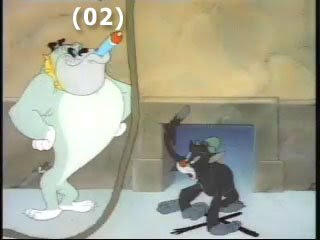Consider this scramble "take" from Tex Avery's very funny Bad Luck Blackie. Just watch this and feel how perfect the cat's scramble fits the moment.
Bad Luck Blackie- scrambled legs from klango on Vimeo.
Who thinks like that today? Who even tries it? But this stuff is really cool! If we're not careful this would slip right by us. In fact it slipped by me the first 20+ times I watched the short. Then it jumped at me. "What the heck was that?!" So I framed through it and I was even more confused. Here are the drawings (shot on 2's, meaning each drawing is exposed for two frames on the film resulting in a 12 frames per second playback)
In motion those drawings absolutely work. We understand it as controlled chaos that has a rhythm and a flow that fits into the film so seamlessly that it easily escapes our notice. It makes perfect sense to our eyes. But laid next to each other in stillness these drawings defy easy analysis. From drawing to drawing the body parts go all over the place, seemingly with little sense of connection between where they were and where they are and where they are going. There aren't many well defined motion arcs going on here and pretty much no breakdowns between the extremes to give a sense of continuity of motion. Conventional wisdom might suggest that this should not work- but it does. How? Is it because it's shot on 2's that we give the motion some freedom to be interpreted more loosely? Does the simplistic coloring and cel painting contribute to the overall effectiveness of the action? Does the ludicrous nature of the 'story' cause us to let it slide? Would this only work in hand drawn animation? Could the same work in CG? What about stop-motion? Or cut out? Is the current trend for using animation on 1's (especially in CG) something that wouldn't allow such craziness? And is there anything in the TV limited animation realm of today that would preclude using this technique (other than the drawings being very 'off model')? I'm very curious as to what combination of ingredients are absolutely critical to making this work.
Sadly most of the old experienced practitioners of this animation style have passed on. How many animators today have a firm grasp on these techniques and can pass them along? For many of us this kind of analysis is the only way we can learn it.








6 comments:
Thank you very mucho for this type of analysis. Is really cool hear this things of people like you, who knows much about the world of animation.
Anyway, sorry for my poor English, but I want to thank you :)
Cheers
Yup! Tex's animators were top notch at this kind of magic.
I used to frame through old 16mm prints of Droopy cartoons to study Tex's sense of timing. Very eye opening indeed. And a much truer sense of timing that we can get from framing through a video frame rate conversion. (I love quicktime, but I miss film.)
I looked like he turned into a twerling wheel, genius.. The shapes was all cohesive and a good flow that it appeared seamless.
Brilliant! I'm to going to try that out in CG. I'm pretty sure it will work. The gig I'm on right now just so happens to be a perfect fit for this sort of take.
And after reading Animator's Survival Kit I still have this mantra from Richard Williams in my mind: "break the joints"
=D
Great analysis on a great shot. Thanks for sharing.
I always thought that Tex Avery's work showed how much an animator can have fun at work... personally i think that his crazyness made me and makes millions of people say "i want to be an animator" at early ages.. cuz of those "non-sense" motions and shapes thrown on screen making sense to our eyes and comedy...but not to any nowadays animation master class..
thanx for sharing this analysis! :)
Post a Comment